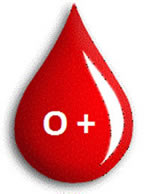Difference between O+ and O- Blood Group
Key difference: The blood groups O+ and O- are universal donors. The only difference is in the recipients to whom the blood is transfused; O+ can be transfused to any positive blood groups, whereas O- is transfused to both positive as well as negative blood groups.
 O+ blood group is a common blood group among most of the people. Around 37% of the population possesses this blood group. This blood group can be transfused to any of the positive blood groups. It lacks the antigen in the red blood cells. These blood group donors are considered as a crucial donor, as it maintains the criteria of the platelet value. O+ blood group can be given to anyone who has Rhd positive blood group; and which is found in around 83% of the population.
O+ blood group is a common blood group among most of the people. Around 37% of the population possesses this blood group. This blood group can be transfused to any of the positive blood groups. It lacks the antigen in the red blood cells. These blood group donors are considered as a crucial donor, as it maintains the criteria of the platelet value. O+ blood group can be given to anyone who has Rhd positive blood group; and which is found in around 83% of the population.
O+ blood group possess the double red blood cells. These blood group people have both anti-A and anti-B antibodies in the plasma, which act against the type A and type B blood. They are said to have the quality, of increasing the lifesaving capacity.

O- Blood group is one of the rare blood groups available in the society. They are also universal donors, and are donated to all the blood groups. They can be transfused to any person at the time of need. They are real “unique” universal donors. They comprise of only 6.6% of the population.
Type O- blood group lacks the Rh factor and also, the anti-A and anti-B antibodies in the plasma, hence it can be safely given to all the blood groups. O- Blood is generally carried in the medical helicopters, in the case of emergency; hence it acts as a real universal donor. It is also found that O- blood groups are safe for the new-born babies in the case of emergency.
Comparison between O+ and O- blood groups:
|
|
O+ blood groups |
O- blood groups |
|
Percentage |
They are present among 37 % of the population. |
They are present among 6.6 % of the population. |
|
Presence of anti-A and anti-b antibodies |
This blood group people have both anti-A and anti-B antibodies in the plasma. |
This blood group people lacks the anti-A and anti-b antibodies in the plasma. |
|
Rh factor |
It has the Rh factor in its cell membrane. |
It does not have the Rh factor in its cell membrane. |
|
Can be transfused to |
They can be given to A+, B+, AB+, and O+ blood group people. |
They can be given to all the blood-groups A+, B+, AB+, A-, B-, AB-, O- and O+. |
|
Acts as |
It is used generally bas a substitute if O- is not available. |
It is commonly used in the case of emergency cases. |
|
Availability |
They are available in the society, in case of emergency. |
They are rarely available in the society, at the time of emergency. |
Image Courtesy: bloodgroups.net









Comments
deep singh
Tue, 03/27/2018 - 15:17
Sssss
Thu, 01/11/2018 - 21:20
purna
Wed, 12/20/2017 - 09:14
Harry
Tue, 01/30/2018 - 15:40
Forrest
Tue, 01/02/2018 - 05:21
Christian
Fri, 09/08/2017 - 02:49
SANFORD THE GAMER
Mon, 06/05/2017 - 18:40
I study mls
Wed, 01/31/2018 - 20:25
kamalamar
Fri, 03/17/2017 - 17:29
daa
Mon, 05/29/2017 - 15:33
Pages
Add new comment